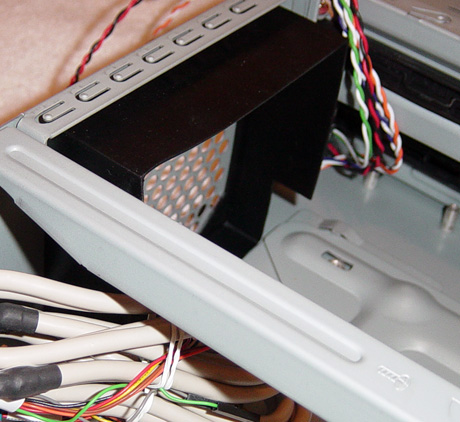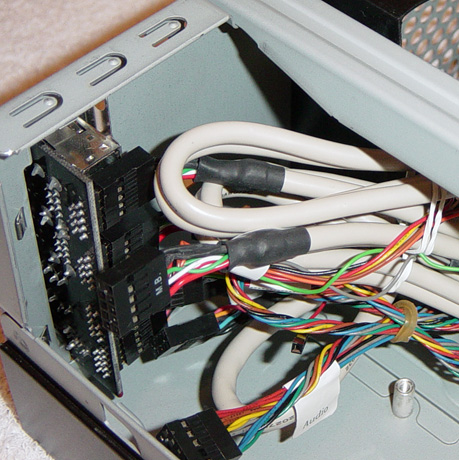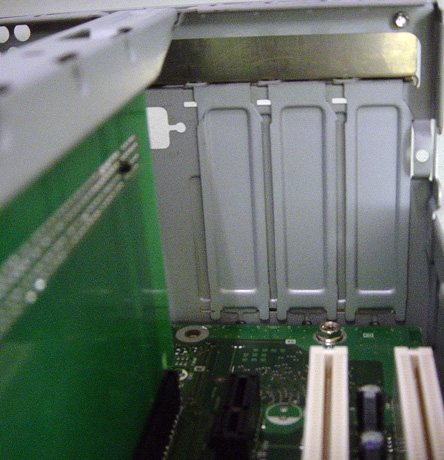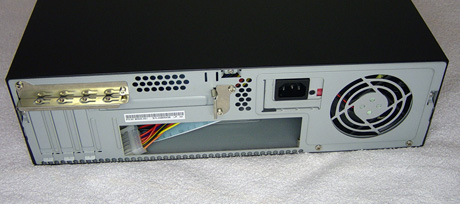Intel's Long Awaited BTX Form Factor
by Purav Sanghani on November 15, 2004 5:31 AM EST- Posted in
- Cases/Cooling/PSUs
First Look: AOpen B300 BTX case cont'd
Internal Design cont'dAt the front of the case is a rubber surround which the thermal module will fit into to provide insulation and to keep warm air from seeping back into the case. To the left of that we see a support bar which spans the depth of the B300 from front to back. As we will see later this bar provides support not only for the structure of the case, but also to hold the PCIe riser card in place. To remove this bar there is a screw at the front of the case that needs to be removed. We then lift the bar from the front, pivoting the backside in its slot and pull up.

Click to Enlarge
To the left of the bar is the auxiliary port module which is home to the internal USB, audio, and FireWire connections. This module is designed with headers so unused ports can be unplugged from the inside to reduce clutter. We also notice that the front panel connections (power/reset buttons, power/HDD activity lights) are also grouped into a single plug to make things easier. It looks like motherboard and case manufacturers are finally working together to standardize more than just the location of the CPU.

Click to Enlarge
The backside of the case consists of 3 vertical half height expansion slots and one full height slot which is positioned horizontally. This, we can safely assume, is where the PCIe x16 VGA card will reside. The I/O backplate is positioned beneath this full length slot.

Click to Enlarge
To secure expansion cards in place there are devices in place on the outside of the B300. Each device, one for the single PCIe x16 slot and one for the other three expansion slots, can be undone by removing a single screw and then pivoting them off the cards' brackets. This feature reduces the number of screws needed but, unfortunately, does not make it a tool-less feature.

Click to Enlarge
Installation
Installing the motherboard was simple since there wasn't much to get in the way if it. We placed the D915GMH on the stand-offs and applied the included screws. We did notice that the tool-less optical mounting device on the inside of the drive bay could not be opened once the motherboard was in place. Luckily the lower HDD bay can be removed by undoing a single screw and sliding the bay back towards the power supply.

Click to Enlarge
There was still an issue with those tool-less devices interfering with the thermal module's fan power header on the motherboard. Unless we plugged in the power cable before replacing the drive bay, it would not stay in place on the motherboard header. We again would need to remove the HDD bay to plug the cable back into the motherboard.

Click to Enlarge
Besides those issues all other parts of the installation carried on smoothly. Our optical drive installed without a hitch since there was nothing to get in the way of the tool-less mounting devices. However, we ran into a clutter problem with the cabling behing the drive bays. As we mentioned earlier the 3 inches of clearance was just not enough to work freely with drive cables, and if it weren't for SATA, there would have been no way to run an IDE ribbon cable to the IDE header on the motherboard. For those that only have the IDE option, we suggest sticking with rounded cables if dealing with this combination of hardware.










77 Comments
View All Comments
DerekBaker - Monday, November 15, 2004 - link
#25From here I should think: ">From the picture we see the flow of warm air pulled forward from beyond the VGA card. As it moves towards the front of the case the air flows over the Southbridge and Northbridge passively cooling each chip. We then see from the shades of red the air warms up as it flows through the CPU heatsink then begins to cool as it moves out the front of the case."
http://www.anandtech.com/casecooling/showdoc.aspx?...
Derek
Oxonium - Monday, November 15, 2004 - link
Let's see, a new form factor with new case requirements and STILL no standardized connector for the front Power/Reset/LED's/etc.? I'm all for cooler cases, but a standardized connector for those items is something that should have been implemented years ago.HardwareD00d - Monday, November 15, 2004 - link
#24, who cares since athlons run much cooler and don't need this case form factor.Doormat - Monday, November 15, 2004 - link
I heard a rumor that it wont work with Athlon 64 chips or any type of chip that has the memory controller integrated with the processor, because the distance between the processor and the RAM banks are too far. Anyone confirm this?Superbike - Monday, November 15, 2004 - link
Wow AT is back.phisrow - Monday, November 15, 2004 - link
While I agree that the tweaky enthusiast market doesn't have much to gain at the moment by moving from ATX to BTX, especially as most of them are running A64s or praying-for-death overclocked mobile Athlons, I think there is certainly something to be said for the form-factor. It does seem to be more efficient for cooling than your average ATX(especially for small cases). Even if you are running some PentiumM or a derivative thereof, more efficient is still better. After all, if a given case design can cool a high-end Prescott without deafening its user, it can probably cool a brutally overclocked Pentium M with its fans running at half the speed. For that matter, if the trace length issues aren't actually crippling, I would like to see some A64 motherboards in this format.johnsonx - Monday, November 15, 2004 - link
Visualize an office full of MicroBTX Desktop computers. Visualize the women in the office cupping their hands around the heat exhaust... visualize the overclocking tips flowing around the female staff as they strive to increase heat output... visualize the men pouring sweat, desparately trying to duct-tape the front vent to block the hot Intel Air.I'm sorry, but any spec that seeks to exhaust hot air out the FRONT of any case, whether it be a desktop, tower or SFF, is just plain STUPID.
araczynski - Monday, November 15, 2004 - link
my god, after all these years, they fall back on the packard bell mentality...KristopherKubicki - Monday, November 15, 2004 - link
GTMan: Temperatures were certainly taken with the cases closed.Kristopher
GTMan - Monday, November 15, 2004 - link
I wonder if all those temperature measurements were done with the case open? I would think a case designed for efficient air flow would only perform properly (as designed) when fully assembled!!!